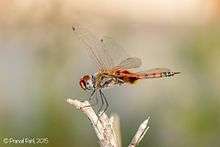Tramea basilaris
Tramea basilaris,[2] also known as the keyhole glider, red marsh trotter,[3][4] or wheeling glider, is a species of dragonfly in the family Libellulidae.[1] It is found throughout most of Africa, Arabia and in Asia.[5] Similarly, this species is able to use the trade winds to reach the Caribbean and South Americas, where it was caught in Suriname, "guadeloupe" and "martinique" (Meurgey and Picard 2011).[1]
| Tramea basilaris | |
|---|---|
 | |
| male | |
_(11857165716).jpg) | |
| female | |
| Scientific classification | |
| Kingdom: | Animalia |
| Phylum: | Arthropoda |
| Class: | Insecta |
| Order: | Odonata |
| Infraorder: | Anisoptera |
| Family: | Libellulidae |
| Genus: | Tramea |
| Species: | T. basilaris |
| Binomial name | |
| Tramea basilaris (Palisot de Beauvois, 1817) | |
| Synonyms | |
| |
Description and habitat
It is a medium sized red dragonfly with extremely long anal appendages. It can be distinguished from other species of this genus by the two brownish black hind-wing patch surrounded by a golden yellow areola in the base. Female is similar to male; but yellowish in color.[6]
This species is found at pools, ponds, marshes, lakes and water tanks. Typical reproducing habitats are grassy marshes and ponds, but this species may be found anywhere during migrations. They are seen in tireless soaring flight in sunny days, sometimes in conspecific groups or in mixed groups of other soaring dragonflies like Pantala flavescens or Hydrobasileus croceus. It perches on exposed twigs; sometimes with the abdomen held downwards to balance in wind.[6][7][3][4]
See also
- List of odonates of Sri Lanka
- List of odonates of India
- List of odonata of Kerala
References
- Clausnitzer, V., Suhling, F., Dijkstra, K.-D.B., Dow, R.A., Boudot, J.-P., Schneider, W. & Samraoui, B. (2016). "Tramea basilaris". IUCN Red List of Threatened Species. 2016: e.T60049A83871612.CS1 maint: uses authors parameter (link)
- Martin Schorr; Dennis Paulson. "World Odonata List". University of Puget Sound. Retrieved 12 Oct 2018.
- "Tramea basilaris Palisot de Beauvois, 1817". India Biodiversity Portal. Retrieved 2017-02-17.
- "Tramea basilaris Palisot de Beauvois, 1817". Odonata of India, v. 1.00. Indian Foundation for Butterflies. Retrieved 2017-02-17.
- K.A., Subramanian; K.G., Emiliyamma; R., Babu; C., Radhakrishnan; S.S., Talmale (2018). Atlas of Odonata (Insecta) of the Western Ghats, India. Zoological Survey of India. pp. 383–384. ISBN 9788181714954.
- C FC Lt. Fraser (1936). The Fauna of British India, including Ceylon and Burma, Odonata Vol. III. Red Lion Court, Fleet Street, London: Taylor and Francis. pp. 432-434.
- C FC Lt. Fraser (1924). A Survey of the Odonate (Dragonfly) Fauna of Western India and Descriptions of Thirty New Species (PDF). p. 445.
External links


